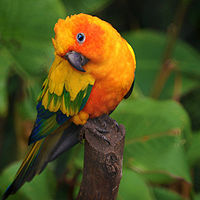Parakeet
 From Conservapedia
From Conservapedia | Parakeet | |
|---|---|

| |
| Sun conure Aratinga solstitialis | |
| Scientific classification | |
| Kingdom Information | |
| Domain | Eukaryota |
| Kingdom | Animalia |
| Subkingdom | Bilateria |
| Branch | Deuterostomia |
| Phylum Information | |
| Phylum | Chordata |
| Sub-phylum | Vertebrata |
| Infraphylum | Gnathostomata |
| Class Information | |
| Superclass | Tetrapoda |
| Class | Aves |
| Sub-class | Neornithes |
| Infra-class | Neoaves |
| Order Information | |
| Superorder | Psittacimorphae |
| Order | Psittaciformes |
| Family Information | |
| Family | Psittacidae |
| Population statistics | |
Parakeet is a name given loosely to many different species of parrots, often unrelated, and sharing some general characteristics such as small-to-medium size and long tails. As with parrots, some parakeet species are popular as pets, with the budgerigar (Melopsittacus undulatus) the most popular cage bird of any kind.
Contents
Description[edit]
Generally-speaking, parakeets are 8 to 24 inches in length. Parakeets have an upright stance when perched; when not flying they move about in the trees using their hooked beak as a climbing aid. On the ground they walk with a rolling gait, their long tails slightly elevated off the ground. Both feet are zygodactyl, i.e. two toes in front, two toes behind, a trait shared with owls and woodpeckers. With the exception of the budgerigar, parakeets use one foot as a "hand" to hold and bring food to its mouth.
Parakeet plumage is also unique in that the brilliant colors are not the result of diet; they are made directly within the feathers by a set of five pigments, or psittacofulvins, a trait found in no other bird species.[1]
Diet[edit]
Fruits, seeds, and nuts make up the diet of most parakeets, with flocks in large numbers often taking advantage of human crops. In India, Sri Lanka, and Burma, farmers have to contend with large flocks of rose-ringed parakeets (Psittacula krameri), which inflict heavy losses on orchards, wheat fields, and rice paddies, while in Malaysia the long-tailed parakeet (Psittacula longicauda) strips the pulp from oil palms; in both cases farmers have to kill a large number of birds to maintain control and reduce their losses, a tactic which resulted, in part, in the extinction of the Carolina parakeet (Conuropsis carolinensis) in the United States.
Phylogeny[edit]
The following families and genera have species which are named or have been referred to as parakeets. The term conure has been in use primarily by aviculturalists, in part to differentiate these New World birds from similarly-named Old World parakeets in the pet and millinery trades. The name rosella is a corrupted form of "Rose Hill", a location in New South Wales, Australia, and derived from the original name of "rosehill parakeet" given to the bird by early European settlers.
References[edit]
↧ Download as ZWI file | Last modified: 03/08/2023 18:24:57 | 13 views
☰ Source: https://www.conservapedia.com/Parakeet | License: CC BY-SA 3.0
 ZWI signed:
ZWI signed: KSF
KSF